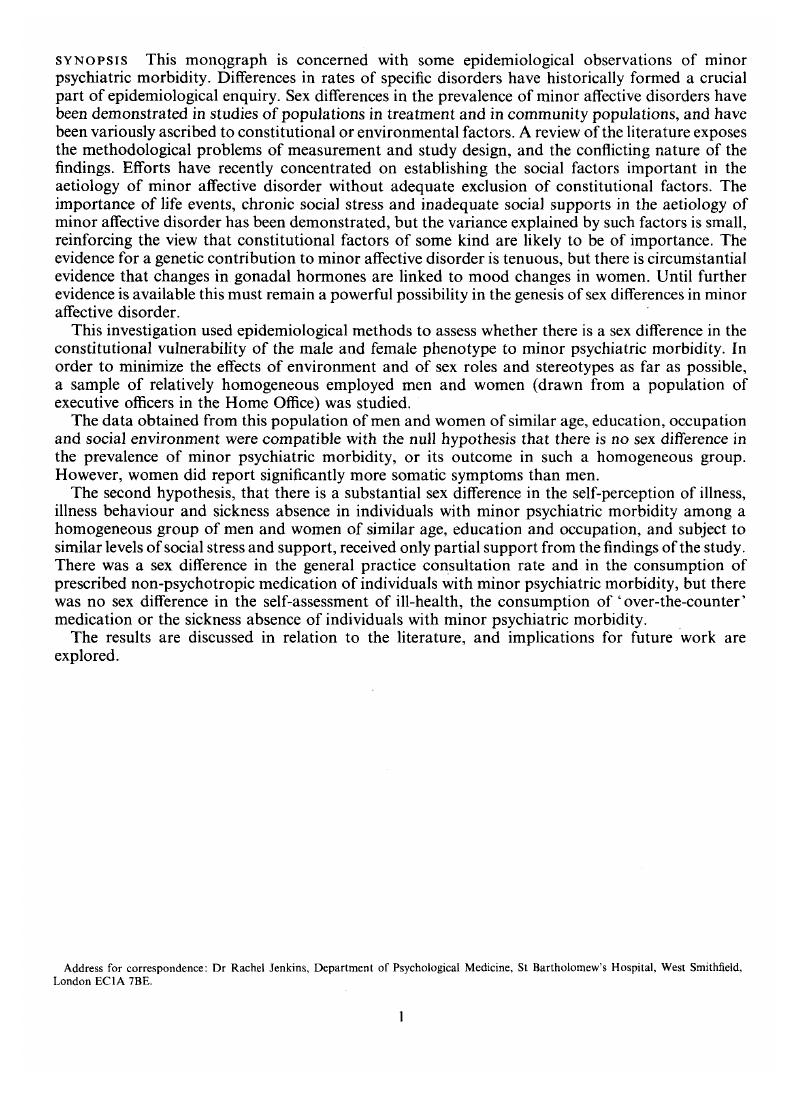Crossref Citations
This article has been cited by the following publications. This list is generated based on data provided by Crossref.
JENKINS, RACHEL
1986.
Sex Differences in Alcohol Consumption and its Associated Morbidity in Young Civil Servants.
British Journal of Addiction,
Vol. 81,
Issue. 4,
p.
525.
Angst, J.
1987.
Affektive Psychosen.
Vol. 5,
Issue. ,
p.
51.
Cheng, Tai Ann
1989.
Symptomatology of minor psychiatric morbidity: a crosscultural comparison.
Psychological Medicine,
Vol. 19,
Issue. 3,
p.
697.
Jenkins, R.
1989.
Occupational Health Practice.
p.
73.
Cheng, T. A.
1989.
Urbanisation and minor psychiatric morbidity.
Social Psychiatry and Psychiatric Epidemiology,
Vol. 24,
Issue. 6,
p.
309.
HUNT, HEATHER
1989.
An Assertiveness and Self-Confidence Group for Women: A Primary Prevention Project in Primary Care.
Clinical Psychology Forum,
Vol. 1,
Issue. 22,
p.
19.
McGuffin, Peter
and
Katz, Randy
1989.
The Genetics of Depression and Manic-Depressive Disorder.
British Journal of Psychiatry,
Vol. 155,
Issue. 3,
p.
294.
Wilhelm, Kay
and
Parker, Gordon
1989.
Is sex necessarily a risk factor to depression?.
Psychological Medicine,
Vol. 19,
Issue. 2,
p.
401.
Lewis, Glyn
and
Pelosi, Anthony J.
1990.
The Case-Control Study in Psychiatry.
British Journal of Psychiatry,
Vol. 157,
Issue. 2,
p.
197.
SWIFT, WENDY
WILLIAMS, GERRY
NEILL, OLWYN
and
GRENYER, BRIN
1990.
The prevalence of minor psychopathology in opioid users seeking treatment.
British Journal of Addiction,
Vol. 85,
Issue. 5,
p.
629.
Jenkins, Rachel
1990.
Towards a System of Outcome Indicators for Mental Health Care.
British Journal of Psychiatry,
Vol. 157,
Issue. 4,
p.
500.
Harris, Tirril
Surtees, Paul
and
Bancroft, John
1991.
Is Sex Necessarily a Risk Factor to Depression?.
British Journal of Psychiatry,
Vol. 158,
Issue. 5,
p.
708.
Sloper, Patricia
Knussen, Christina
Turner, Stephen
and
Cunningham, Cliff
1991.
Factors Related to Stress and Satisfaction with Life in Families of Children with Down's Syndrome.
Journal of Child Psychology and Psychiatry,
Vol. 32,
Issue. 4,
p.
655.
Ernst, C.
and
Angst, J.
1992.
The Zurich Study.
European Archives of Psychiatry and Clinical Neuroscience,
Vol. 241,
Issue. 4,
p.
222.
V�zquez-Barquero, J. L.
Manrique, J. F. Diez
Mu�oz, J.
Arango, J. Menendez
Gaite, L.
Herrera, S.
and
Der, G. J.
1992.
Sex differences in mental illness: a community study of the influence of physical health and sociodemographic factors.
Social Psychiatry and Psychiatric Epidemiology,
Vol. 27,
Issue. 2,
p.
62.
King, M B
Cockcroft, A
and
Gooch, C
1992.
Emotional Distress in Doctors: Sources, Effects and Help Sought.
Journal of the Royal Society of Medicine,
Vol. 85,
Issue. 10,
p.
605.
Araya, R.
Wynn, R.
and
Lewis, G.
1992.
Comparison of two self administered psychiatric questionnaires (GHQ-12 and SRQ-20) in primary care in Chile.
Social Psychiatry and Psychiatric Epidemiology,
Vol. 27,
Issue. 4,
p.
168.
Popay, Jennie
Bartley, Mel
and
Owen, Charlie
1993.
Gender inequalities in health: Social position, affective disorders and minor physical morbidity.
Social Science & Medicine,
Vol. 36,
Issue. 1,
p.
21.
Henderson, A. S.
Jorm, A. F.
Mackinnon, A.
Christensen, H.
Scott, L. R.
Korten, A. E.
and
Doyle, C.
1993.
The prevalence of depressive disorders and the distribution of depressive symptoms in later life: a survey using Draft ICD-10 and DSM-III-R.
Psychological Medicine,
Vol. 23,
Issue. 3,
p.
719.
Coutinho, E. da S. Freire
Filho, N. de Almeida
Mari, J. de Jesus
and
Rodrigues, L.
1996.
Minor psychiatric morbidity and internal migration in Brazil.
Social Psychiatry and Psychiatric Epidemiology,
Vol. 31,
Issue. 3-4,
p.
173.





